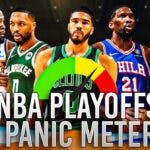The rise of Boston Celtics guard Terry Rozier has been something to witness. Once just yet another Boston asset, Rozier is only a few months removed from being dubbed The Untouchable Terry Rozier, as Danny Ainge would treat the guard like a nuclear weapon whenever trades were rumored.
Since then, Scary Terry Rozier has emerged. This monster of a young man, who has already allowed Celtics fans to move on from Isaiah Thomas like a one-night stand. A rather remarkable move, considering how beloved IT was when donning the green and white.
But how? How has Rozier gone from a social media joke circling around Ainge's love of assets to an integral part of Boston's stunning playoff run? We have theories.
The Brad Stevens System

Before Thomas became a thing for the Celtics, he was a journeyman guard trotting around the NBA with few giving him much thought.
Long before supposed fourth quarter heroics, IT was shooting a lot of the course of several seasons for various teams. Unlike his stint with the Celtics, this high-volume shooting version of the guard was not exactly winning a bunch of games.
In 216 games with the Sacramento Kings, Thomas shot 45 percent from the floor and a more than solid 36 percent from three, but he was also taking six less field goal attempts and three less from beyond the arc than he did in Boston. Of note, those Kings squads were as bad as listening to an in-law wax poetic about politics.

Things got weirder from there, as Thomas' 46 games with the Phoenix Suns resulted in more points, but nearly as much losing as there was in Sacramento.
Obviously, his season away from Boston has only increased the idea of Thomas benefiting largely from whatever the hell it is that Brad Stevens does. Splitting time between the Cleveland Cavaliers and Los Angeles Lakers, IT finished this season shooting a woeful 38 percent from the floor and merely 33 percent from distance.
To be fair to him, and it is important to note, Thomas entered the season injured. Also, being a high-usage player, but being placed with two different rosters that had no place for one, didn't help.
The point remains (relatively) the same: IT's only winning in the NBA came in Boston. His best statistical seasons came under Brad Stevens. It begs the question to be asked — Isaiah Thomas' run with the Celtics is all about who?
Both. The answer here is both Brad Stevens and Thomas played a hand in the guard having three excellent seasons with the Celtics. That being said, with the emergence of Rozier, how much more of a hand in it did Boston's system have in it than we realize?
Rozier Before IT Left

Scary Terry isn't a long phenomenon. It's practically brand spanking new.
While it should be worth valuing the idea of developing, primarily a young player in his third season, there's also a change of role for how Rozier has been used. Prior to this season, Scary Terry was nothing more than a rotational guard tasked to do a few things for the Celtics. However, with Thomas leaving the team in the offseason, coupled with key injuries to other high-usage players, Stevens had to turn to someone to play the role of offensive-eater-of-worlds.
Enter: Scary Bleeping Terry Rozier.
Before this season, it could be argued that Rozier was objectively bad. That Ainge's idea of him, as this unreal young talent, was as realistic as me expecting Christina Ricci to go out on a date with me simply because I mentioned her in this column. After all, there was a reason for The Untouchable Terry Rozier jokes on the mean streets of Twitter.

As a rookie, Rozier only saw eight minutes per game, shooting an abominable 27 percent from the floor and 22 percent from three. Again, to be fair, being young in the NBA is #hard. During his second season, though, it was more of the same, as Rozier shot a still-awful 37 percent from the floor and an OK-ish 32 percent from three.
Then, well, this season happened.
Rozier remained still ineffective from the floor this season, shooting under 40 percent, but raised his 3-point shooting to a tremendous 38 percent. But that's not all. In the NBA Playoffs, with no Kyrie Irving around to be the high-usage guy, Rozier has risen from the ashes like some sort of mythological beast, not only scoring 18.3 points per game (up seven from his regular season average), but making 44 percent of his field goal attempts and 40 percent of his attempts from beyond the arc.
What in the hell?

The idea here is rather simple if we start with this baseline idea: Stevens likes his primary ballhandler to be his high-usage talent on the offensive end. It went from IT to Kryie and that role, with Irving out, has now been handed to Rozier.
In fact, the numbers speak from themselves.
To keep the sample-size somewhat purposely limited, as Rozier's regular season numbers aren't why Scary Terry has emerged, we will use Rozier's playoff numbers and compare them to Irving's regular season numbers with Boston and Thomas' last playoff run with the Celtics.
Also worth keeping in mind: Thomas was 27 during last year's playoffs, Irving was 25 this season, and Rozier is currently only 23.

Both Irving's (31) and Thomas' (31.3) usage rates were absurd using the aforementioned sample, with each chucking it from the floor over 17 times per game. For Rozier, his usage rate is not nearly as insane, but is near the higher level of 20.9 in this postseason. Furthermore, he's shooting it 14-times per game, up from his 10 per in the regular season. As importantly, he's shooting three more 3-pointers per playoff game than he was in the regular season.
A logical person would assume that this larger role in the postseason would expose a player who had less-than regular season numbers, but this hasn't been the case for Rozier.
The Who/What For This Rise
As it was for Thomas, Rozier entering the void as some ho-hum prospect then leaving that abyss as the next-coming of some superstar has to do with everyone involved. A little Brad Stevens here, a little Rozier over there, with a sprinkle of natural player-development in the middle.

Noted earlier was the age of Rozier. The youngest of the three high-usage players at the time of their Boston Dominance (or whatever), he had the least amount of NBA experience before being inserted in this role Stevens seemingly loves to have be played on his teams.
He was also never asked to play this role until Irving went down with injury this season, leaving us only with the NBA Playoffs for our Scary Terry statistic sample-size.
And, yes, there's clearly a difference between Untouchable and Scary Terry. While everything else in this column is up for debate, this is not. It's essentially the difference between normal Carmelo Anthony and Hoodie Melo, but with a less polarizing player.

Anyway, Rozier appears to be good. He's not purely a product of the system, but one who has taken advantage of an opportunity presented to him.
As it usually is with the sort of questions that ask who is responsible for what, the answer to who is to get credit fort the rise of Scary Terry Rozier is all. At the same time, this trend has to be noted. This apparent “replaceable” — if only replaceable-ish — feel the high-usage designation has for the Boston Celtics.
Maybe it means nothing. Maybe it isn't even real. But if it is, even if only in the slightest, it simply means Brad Stevens has unlocked some brilliant code which can result in nearly every top-100 offensive player being able to excel in that role within his scheme.
If that's true, that's pretty dang neat. That gives Boston an incredible amount of options as long as Stevens is the head coach. If not, well, settling for having a super awesome Scary Terry Rozier is pretty swell itself.
Either way, Boston wins the day.



